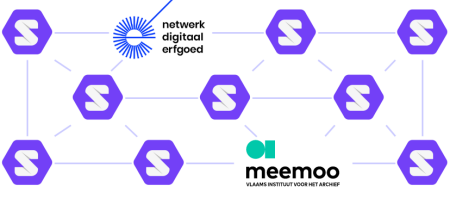Dutch Digital Heritage Network, Ghent University and meemoo delve into decentralised web technologies
18 Sep 2020Information is one of the most significant raw materials of our time: we exchange it and share it with each other, enriching it all the time. But how do you make sure this information can be shared and exchanged in such a way that it’s displayed consistently and uniformly across different platforms? Enter: the decentralised web.
Over the next few years, we’ll be investigating – together with the Dutch Digital Heritage Network and Ghent University – how this concept can be deployed. Specifically, meemoo will be looking at how to ensure gains in efficiency and improved scalability for the influx of digital collections and metadata updates.
What is the decentralised web?
But first, what actually is the decentralised web? Instead of building a new, centralised system, you connect all the existing collection management systems and data sources together, and add then new ones as they’re created. This way of working moves away from closed information silos and aggregator networks, and makes connections via linked data. One important benefit this brings is data mobility: it makes it much easier to change supplier and take your data with you.
Our collaboration with the Dutch Digital Heritage Network and Ghent University is exploring the usability of concepts from the decentralised web and Solid for exchanging digital heritage. This means an individual or organisation manages a personal domain and associated storage space – a data pod – as a fixed exchange hub where they share information with external services. The administrator provides service provider applications with selective access to information stored in the data pod.
Using meemoo as an example: a content partner’s metadata – which is associated with content saved in that partner’s system or data pod – can be displayed in the meemoo archive system and on access platforms hosted by content partners, meemoo and others. This means objects that are stored by content partners are also displayed on other platforms such as municipal databases, the Flemish Art Collection and hetarchief.be.

Metadata collection is managed in a Solid datapod on the content partner's side and is exchanged from there with meemoo, other institutions or the digital heritage network.
Three partners, one common goal
At meemoo, we manage the influx of audiovisual content and metadata for over 150 content partners. These content partners rely heavily on our services and infrastructure to manage their own content and provide it with metadata. In this project, we’re investigating how to optimise the influx of this data and metadata, including updates, within the context of a decentralised web environment.
In this instance it therefore revolves around heritage data, but we’re hoping the results will also support the other, different types of institutions that meemoo is affiliated with. We're focusing on innovations in digitisation and digital literacy by publishing data as linked data, and linking it with external metadata sources.
The Dutch Digital Heritage Network is making the use case for publishing digital heritage and providing access to it from a Dutch context. It will then assess the research results based on the above principles and apply them in its operations where possible. The project must demonstrate that an infrastructure such as this is technically feasible and that a subsequent process for implementing it in the Dutch (and Flemish) heritage sector will be useful.
The collaboration with the UGent-IDLab research group is crucial considering their expertise in the decentralised web and linked data technology. They are heavily involved with the Solid project, which they’re applying in various domains such as government, e-health, HR, retail, etc. The fact that they can now explore this digital heritage domain further will help their development and give them a sales market to ensure the research results are useful.
